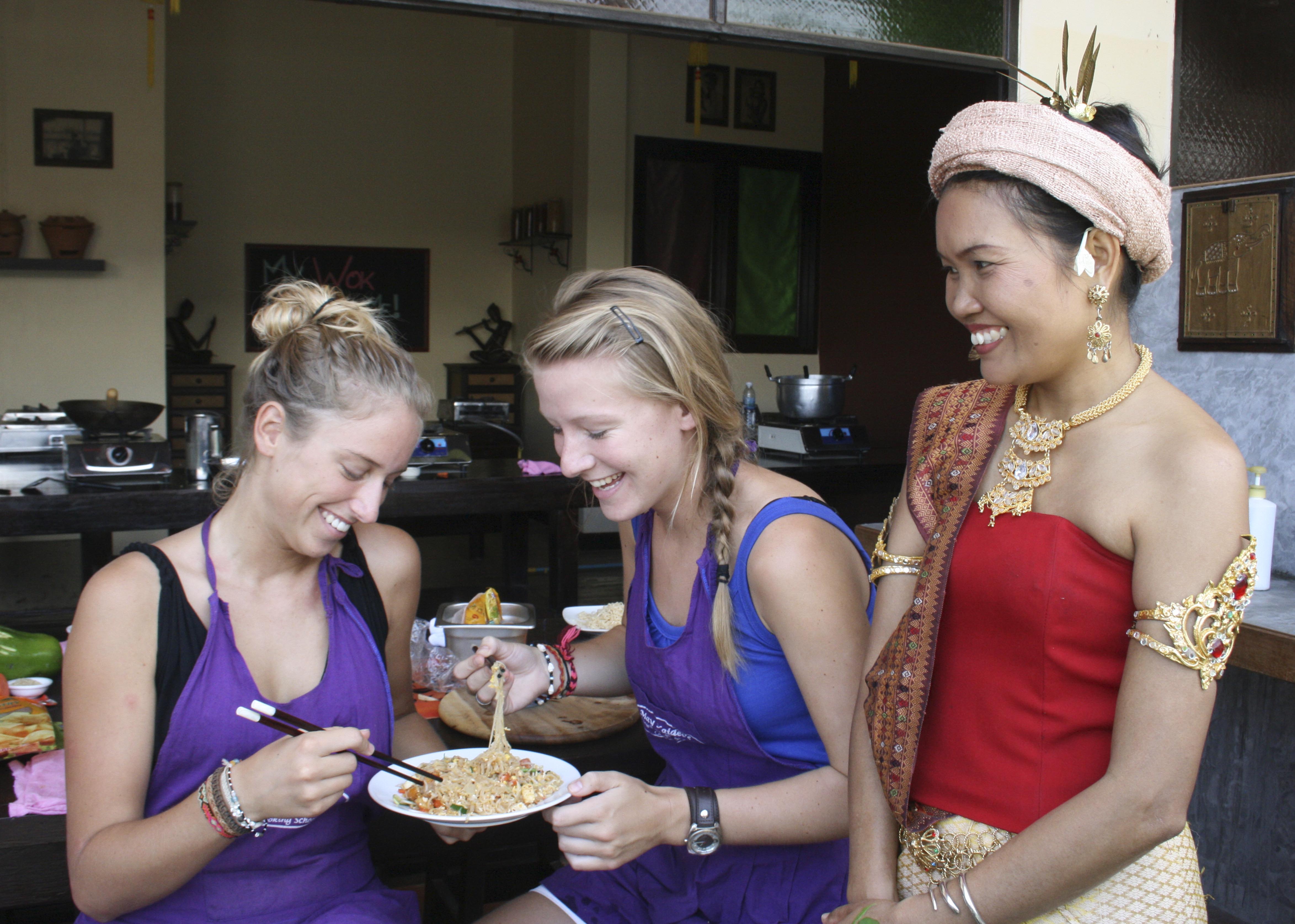
Our cooking schools are known to vegetarians and vegans throughout the world, and we offer instruction for beginners and experienced chefs alike. Our Thai cooking class is offered as a half day program beginning at 9am in the morning and 2pm in the afternoon. Schedules for both the morning and afternoon classes are listed below.
May Kaidee's cooking school has been around since 1988 and we've proudly hosted thousands of vegetarian and non-vegetarian students since then from over 50 different countries. Even if you are not vegetarian, we encourage you to try our culinary experience and be pleasantly surprised at how fulfilling and informative our classes can be in learning how to make delicious Thai dishes.

During this time students get acquainted with the instructor and fellow students.
Students are offered fresh fruit such as Papaya, Mango or Dragonfruit, and a bottle of spring water.
Each student receives our special course notes booklet to review, which is later read in more detail during the hands-on cooking phase.
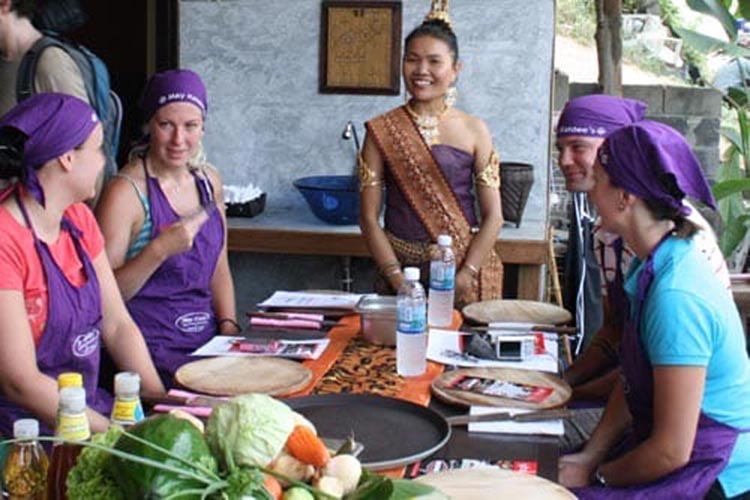
A lesson on making chili paste is taught prior to the main lesson. Many students for the first time have the experience of using a mortar and pestle for food preparation, which is a common tool in Thai cooking that liberates an array of scents and tastes from the fresh raw ingredients used in chili paste. In Chiang Mai we begin the class by teaching red, green and Tom Yam chili paste. In Bangkok we teach green chili paste and Tom Yam chili paste.
During the chili paste making demonstration, the instructor leads a discussion of Thai spices and herbs. Students are also introduced to a range of native vegetables and fruits, as well as oils and sauces important for Thai cooking. Lemongrass, Galangal, Kaffir Lime Leaves are among the primary ingredients that will be new to students not previously familiar with Thai cooking, used in popular dishes such as Tom Yam soup and Tom Kha soup. Equally important ingredients discussed include Spicy Basil, Sweet Basil, Coriander and <a href="/ingredients/chinese-ginger">fingerroot (Chinese ginger)</a>.

During the main lesson time you will learn to cook the following recipes:
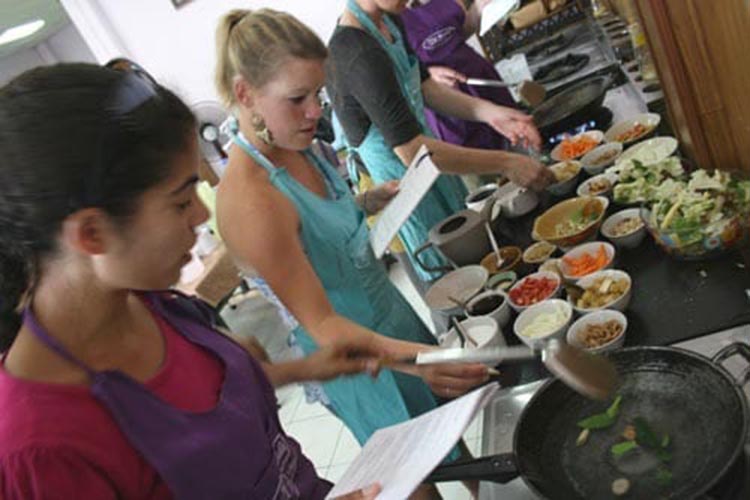
Students are allowed a short time to sit and rest, as well as discuss the techniques learned during the course. In Chinag Mai fresh spring rolls and pumpkin hummus. In Bangkok papaya salad and deep fried rolls.

Concluding remarks are made by the instructor and students may take notes at this time.
Students finish the class by learning to make Sticky Rice and Mango dessert.
* Note: Drinks ordered at this time cost extra and are not included with the class fee.

* Note: By default the afternoon class is the same as the morning, but the class tends to move faster since it is usually smaller. As in our morning class, students spend time becoming acquainted with the instructor and fellow students. Afternoon students also have the option to choose a custom recipe set if desired.
Each student receives our special course notes booklet to review, which is later read in more detail during the hands-on cooking phase. Students are offered a complementary bottle of spring water at this time.
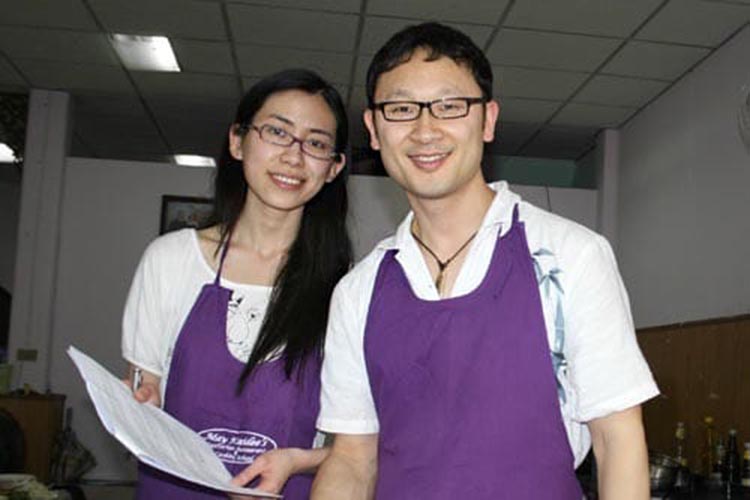
Students who opt to learn cold recipes may begin to make recipes such as Som Tom.
Students engage with instructor on the topic of Thai herbs and spices, covering Galangal, Kaffir Lime Leaves, Spicy Basil, Sweet Basil, Coriander and Chinese Ginger. The discussion also focuses on availability of ingredients outside Thailand as well as the use of substitute ingredients in each student's home country.
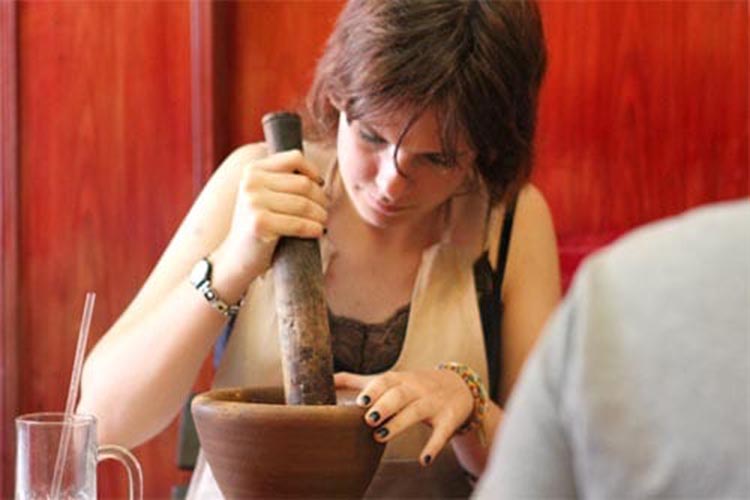
Students begin to make recipes they have chosen at the start of the class. Since our afternoon classes tend to be smaller, students are able to receive more one-on-one attention as well as control the pace of the class to suit personal taste.
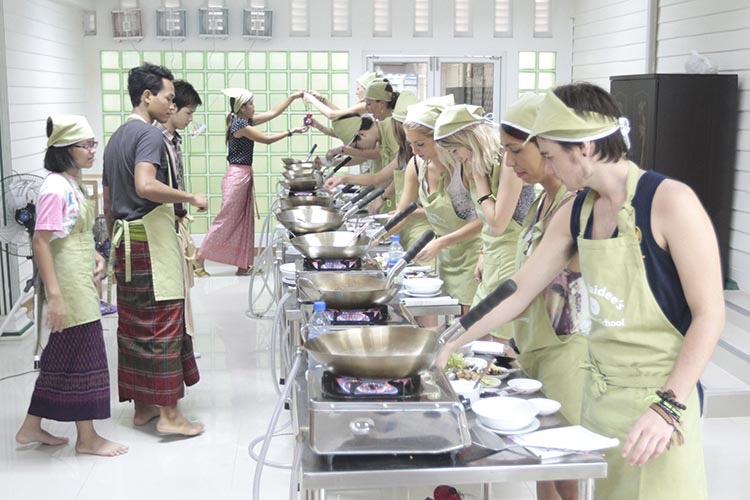
Students are allowed a short time to sit and rest, as well as discuss the techniques learned during the course. Or students can practice the techniques they learned during the class independently during this time. Resting between the hot and cold recipes is important in allowing the body adequate digestion time.
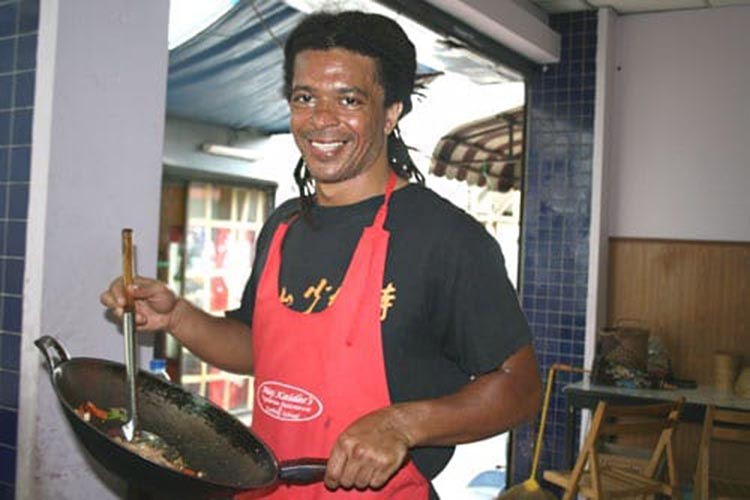
Students are given a tutorial on making fresh spring rolls and papaya salad. Techniques are taught for the delicate steps to making fresh spring rolls.
Students are served a complimentary Sticky Rice and Mango dessert. At this time students may order drinks (extra cost).
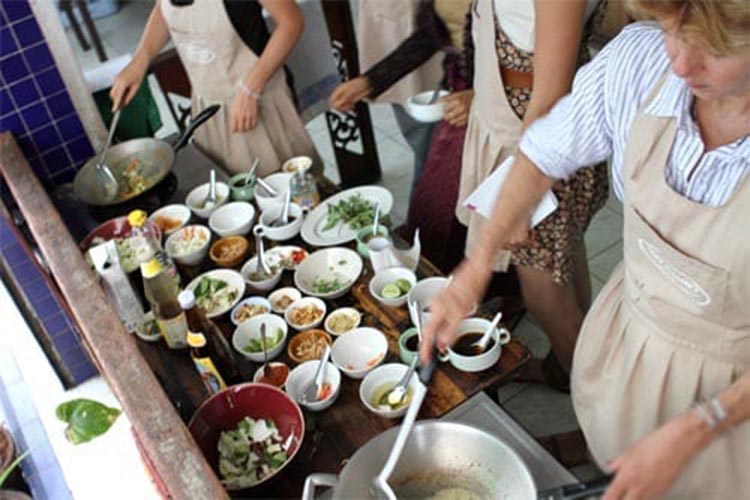
Concluding remarks are made by the instructor and students may take notes at this time.
Students are free to spend time until 6pm independently practicing the techniques they learned during class.

Tom Yam, also known as Tom Yum, is a spicy and sour soup that is a popular dish in Thai cuisine. It is made with a combination of herbs and spices, such as lemongrass, kaffir lime leaves, and galangal, as well as chili peppers, shrimp, mushrooms, and lime juice. The result is a flavorful and aromatic soup that is both spicy and refreshing.
The origin of Tom Yam is believed to be from Thailand, where it has been enjoyed for centuries. The dish is typically made with shrimp, but it can also be made with chicken, pork, or tofu for those who prefer a vegetarian or vegan option. It is often served as a starter or as a main course with rice. At May Kaidee we teach an all vegan version of Tom Yam, without using any animal products, which is just as vibrant and delicious as non-vegan versions.
To make Tom Yam, the herbs and spices are first simmered in a pot until fragrant. The protein is then added and cooked until tender. Vegetables, mushrooms and tomatoes are added next, followed by the broth, which is typically made with stock. The soup is then simmered for a few minutes until the vegetables are tender.
The key to a good Tom Yam is a balance of flavors. The soup should be sour, spicy, salty, and slightly sweet. This is achieved by adding a combination of lime juice, a salty sauce, and sugar to the soup. The soup is then served hot and sometimes garnished with fresh herbs, such as cilantro or Thai basil.
Tom Yam is not only delicious, but it is also believed to have health benefits. The herbs and spices used in the soup have anti-inflammatory properties, and the soup is thought to boost the immune system and aid in digestion. It is a comforting and satisfying soup that is perfect for any time of year, but especially during the colder months when a warm and spicy soup is perfect for elevating one's taste buds and spirit.
Pad Thai is a traditional Thai dish that has become a popular street food and restaurant staple around the world. It is a stir-fried noodle dish made with rice noodles, vegetables, protein (such as shrimp or chicken), and a sweet and tangy sauce. It is usually garnished with peanuts, bean sprouts, and lime wedges.
The origin of Pad Thai is somewhat unclear, but it is believed to have been created in the 1930s or 1940s as a way to promote Thai nationalism and encourage the consumption of rice noodles. It was originally called "phat Thai" and was made with rice noodles, shrimp, tofu, egg, and bean sprouts, all of which were readily available in Thailand. Of course at May Kaidee by default we don't use animal products in our version of Pad Thai we teach in our classes.
To make Pad Thai, first, the rice noodles are soaked in water until they are soft and pliable. The noodles are then drained and set aside. Next, the vegetables are cooked in a wok or frying pan until they are tender and slightly caramelized. The noodles are then added to the pan and stir-fried with the vegetables and optionally protein such as tofu.
The sauce is then added to the pan, which usually consists of tamarind paste, a pinch of sweetner, and chili paste. The mixture is stirred until the noodles are coated evenly with the sauce. The dish is then garnished with chopped peanuts, bean sprouts, and lime wedges.
Overall, Pad Thai is a delicious and satisfying dish that is enjoyed by people all over the world. Its popularity is a testament to the unique blend of flavors and textures that make up Thai cuisine, and it is a dish that is sure to impress anyone who tries it.
Thai sticky rice dessert, also known as Khao Niew Moon, is a popular and delicious dessert made with glutinous rice, coconut milk, and sugar. This dessert is a staple in Thai cuisine and is often served at special occasions, festivals, and celebrations. The preparation of this dessert requires soaking the rice in water for several hours to soften it and allow it to absorb water.
To prepare the dessert, first, the glutinous rice is rinsed with water until the water runs clear. Then, the rice is soaked in water for at least four hours or overnight. After the soaking, the rice is drained and placed in a steaming basket or a cheesecloth-lined colander.
Next, the rice is steamed for about 20-30 minutes until it becomes soft and sticky. During the steaming process, it is important to keep the rice covered with a lid to retain the steam and moisture. Once the rice is cooked, it is transferred to a mixing bowl and allowed to cool down slightly.
In a separate saucepan, coconut milk, sugar, and a pinch of salt are mixed together and heated over medium heat until the sugar is completely dissolved. The mixture is then poured over the cooked sticky rice and mixed well to ensure that the rice is evenly coated with the sweet and creamy coconut sauce.
The dessert is usually served warm and garnished with fresh fruits, such as mango or sliced banana, and toasted sesame seeds or grated coconut. The combination of the soft and sticky rice with the sweet and creamy coconut sauce and the refreshing taste of the fresh fruit creates a mouthwatering and satisfying dessert that is perfect for any occasion. Thai sticky rice dessert is a true culinary delight that is loved and enjoyed by many people around the world.